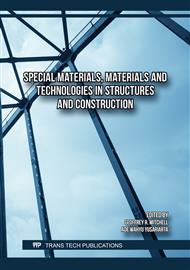p.49
p.63
p.75
p.89
p.101
p.115
p.125
p.131
p.137
Encapsulation in Expanded Clay as an Alternative Protection for Bacteria in Bioconcrete-Influence on Compressive and Tensile Strength
Abstract:
This study explores the potential of self-healing concrete with bacteria encapsulated in calcium lactate and expanded clay (LECA) to enhance the durability and strength of concrete structures. The effect of encapsulating Lysinibacillus sphaericus bacteria in LECA on the mechanical properties of concrete was investigated, including compressive and tensile strength. Calcium lactate acts as a precursor and nutrient source for the biomineralization process through Microbially Induced Calcium Carbonate Precipitation (MICP). Experimental results demonstrate that concrete with bacteria encapsulated in LECA exhibits a significant increase in compressive strength compared to conventional concrete and concrete containing non-encapsulated bacteria. This increase is attributed to the protection provided by LECA to the bacteria and calcium lactate, promoting their self-healing activity and improving the concrete's ability to withstand loads. An increase in compressive load was observed for design DR-5 compared to DR-0 (control), with increments of 3.40%, 0.21%, and 6.92% on days 7, 14, and 28, respectively. However, challenges were identified regarding tensile strength, as design DR-5 was initially lower than design DR-0 by 24.25% and 19.51% on days 7 and 14, respectively. Nonetheless, on day 28, design DR-5 surpassed the control design by 1.45%. This study concludes that the encapsulation of bacteria in LECA, along with calcium lactate as a nutrient source, is a promising strategy for enhancing the performance of self-healing concrete, opening new avenues for research and applications in sustainable construction.
Info:
Periodical:
Pages:
125-130
Citation:
Online since:
October 2025
Keywords:
Price:
Сopyright:
© 2025 Trans Tech Publications Ltd. All Rights Reserved
Share:
Citation:


